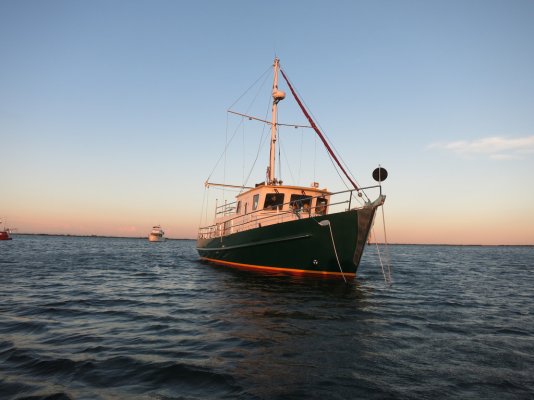Some suggestions. Get a range finder. Inexpensive and they give accurate distances with no fuss or muss. You could use your radar, but the range finder will tell you quickly within a foot or so.
The worst time to anchor in a crowded anchorage is in "no wind or current". You can't tell where anyone's anchor is located or how they are lying to it. Give extra space under these conditions if possible.
So assuming a decent wind or current, the boats' anchors will be in front of them somewhere. Once you know what depth you will be anchoring in, you can figure out your swing room from your scope. So for example, in 10 feet of water with a scope of 5 to 1, you will swing approx. 50 feet in any direction from your anchor (50 foot radius plus your boat length). Ideally then, don't drop your anchor any closer than 50 feet (plus your boat length) (better 100 feet so in theory your circles don't overlap) to another boat. This is a starting point, but often people will come in after you and anchor in between you and another boat, taking up some of the "room" you left.
As Murray stated, the last boat in is the one that is supposed to move if a problem is expected or develops. When a boat comes in and anchors too close, I take photos, note the time and distance measurements and put it into my log, where I have already noted my time of arrival, depth, scope, etc. just in case of an insurance claim (never needed it yet)

. In most cases, people coming in after you will move if asked, especially when told how far away they actually are (how close).
Lay your anchor down at the spot you have determined is good, and when the anchor is on the bottom, slowly back up while laying out your rode. Once your have reached the necessary scope, "set your anchor" by applying reverse throttle to ensure it will hold. Depending on your boat and HP, idle may be enough or part throttle. I am usually happy when my chain rode goes totally taunt and judging by our surroundings we are no longer moving. When the boat is put into neutral, it will move forward, which is another good indicator that you are adequately set.
Don't forget to use a bridle or "snubber" to take the load off the windlass even when "setting".
In a windy crowded anchorage, motor up behind a boat, keeping the correct distance side to side from other boats, and drop your anchor at least "half your scope" back. The boat you are behind should be at or near the end of their scope under those conditions. You will need a minimum of 2.5 times your scope between boats (fore and aft) of where you want to anchor when windy (more would be better).

Better yet, find an anchorage with lots of room.

Some good info from others already. We try for a 5 to 1 scope (unless big winds are expected) but sometimes have to settle for less (never less than 3 to1 for my comfort).
Edit: Always calculate scope for high tide and never anchor in a spot that has less than your boat's draft at low tide

We can have some large tidal swings in our area.




